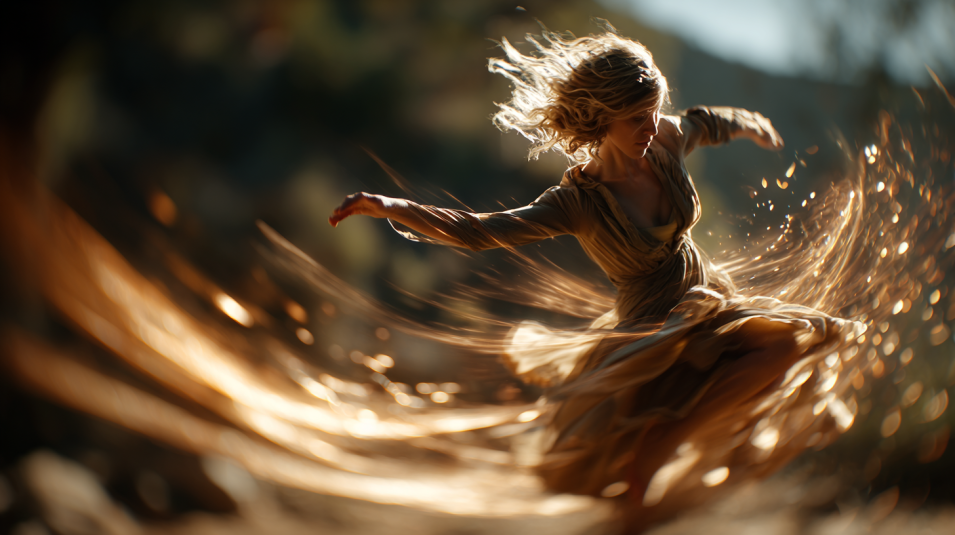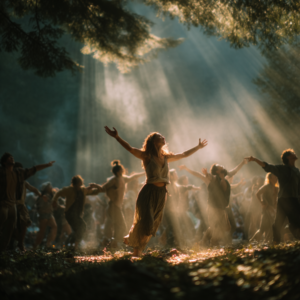At some of our workshops and retreats, we incorporate the ecstatic dance as a tool for physical and emotional exploration.
It is a simple, accessible and profoundly transformative practice that can be found today in many places around the world (perhaps even close to where we live).
That's why we want to share a little more about what it is, where its power comes from, and why it can become a path to self-knowledge and healing.
The ecstatic dance is a practice of liberation, presence and connection.
It is not a dance class or a show. It is a journey through free movement, a deep exploration where the body expresses itself without choreography, without judgement and without the need for words.
In a carefully tended space, guided by a musical wave that takes you from stillness to ecstasy and back to calm, the body recalls its ancestral language: movement as medicine.
What makes it different?
No choreography, no judgement: There are no steps to learn and no "correct" forms. Here you don't dance to be seen, but to feel.
No substances, no talking, no screens: The proposal is to return to pure presence. No distractions, no masks, just you and your breath in dialogue with the rhythm. Sometimes Cacao can be included in a pre-drinking. But other substances are excluded.
A secure container: A space is held where respect, consent and mutual care are essential. Every body has its place, every expression is welcome.
Music in waves: The session builds like an energetic wave: it starts gentle, rises to trance intensity and descends towards integration. This journey facilitates opening, letting go and coming back to you.

Why can he be a healer?
Beyond the symbolic, ecstatic dance is rooted in very real mechanisms of the body-mind. Its power is not just in "dancing", but in how movement, music and group dialogue with our nervous and emotional system.
1. Somatic discharge of stress
When you move freely, you activate the deep muscles, the diaphragm and the respiratory flow. This releases catecholamines (the stress hormones) and restores coherence between heart and breathing.
The body unloads, decompresses and can return to rest.
2. Chemistry of well-being
Dancing is a natural alchemy: it releases endorphins (well-being and analgesia), dopamine (motivation), oxytocin (bonding) and serotonin (balance). These substances create an inner ground of pleasure, security and emotional openness, where inner processes can unfold more smoothly, the body unloads, decompresses and can return to rest.
3. Nervous system regulation (polyvagal perspective)
In the back and forth between rhythm and silence, the body learns to regulate itself.
Dance invites you to oscillate between activation and calm, training vagal flexibility: the ability to come out of "alert" mode and feel at home within yourself. It is a reminder that the body knows how to return to safety.
4. Interoception and emotional literacy
Without choreography, the focus becomes internal.
You listen to your micro-sensations: the weight, the tension, the heat, the impulse. This somatic attention, interoception, is the basis of emotional intelligence. When the body can express itself, emotion doesn't get stuck: it transforms.
5. Pattern unlocking and body update
The body keeps history. Postures, gestures, the way you move are living memories.
Free movement opens up space for new possibilities: standing up where you used to shrink, releasing your jaw, opening your chest.
Each new gesture is an update of your internal map: one more option for safety and freedom.
6. Rhythm and light trance (flow)
When the rhythm envelops you and you stop "thinking" the movement, something changes: the mind quiets down and the flow emerges.
The state of flow (that light trance between mindfulness and surrender) reduces self-demand, turns off the inner voice of judgement and allows awareness to expand.
It is fertile ground for creativity, healing and union with the whole.
7. Belonging and social mirror
Even if you dance inwards, you do it in the presence of others.
The shared silence, the glances, the collective movement generate a resonance field. Mirror neurons are activated and the system perceives: "I am not alone".
The group becomes an energetic womb in which to feel supported and seen without words.
8. Ritual and integration
Each session of ecstatic dance culminates in a moment of stillness, breathing or journaling.
There, movement becomes meaning. The lived experience finds meaning, is integrated, becomes a conscious experience.
That's the difference between moving and transform.

A practice to come back to the body, to the present and to life.
At a time when the mind races and the body forgets, the ecstatic dance reminds us that there is a way back: through the pulse, the sweat, the breath, the heartbeat.
It's not about learning to dance, but about remembering that you know.
That the body always knew.
And when you let it speak, life itself begins to dance with you.


